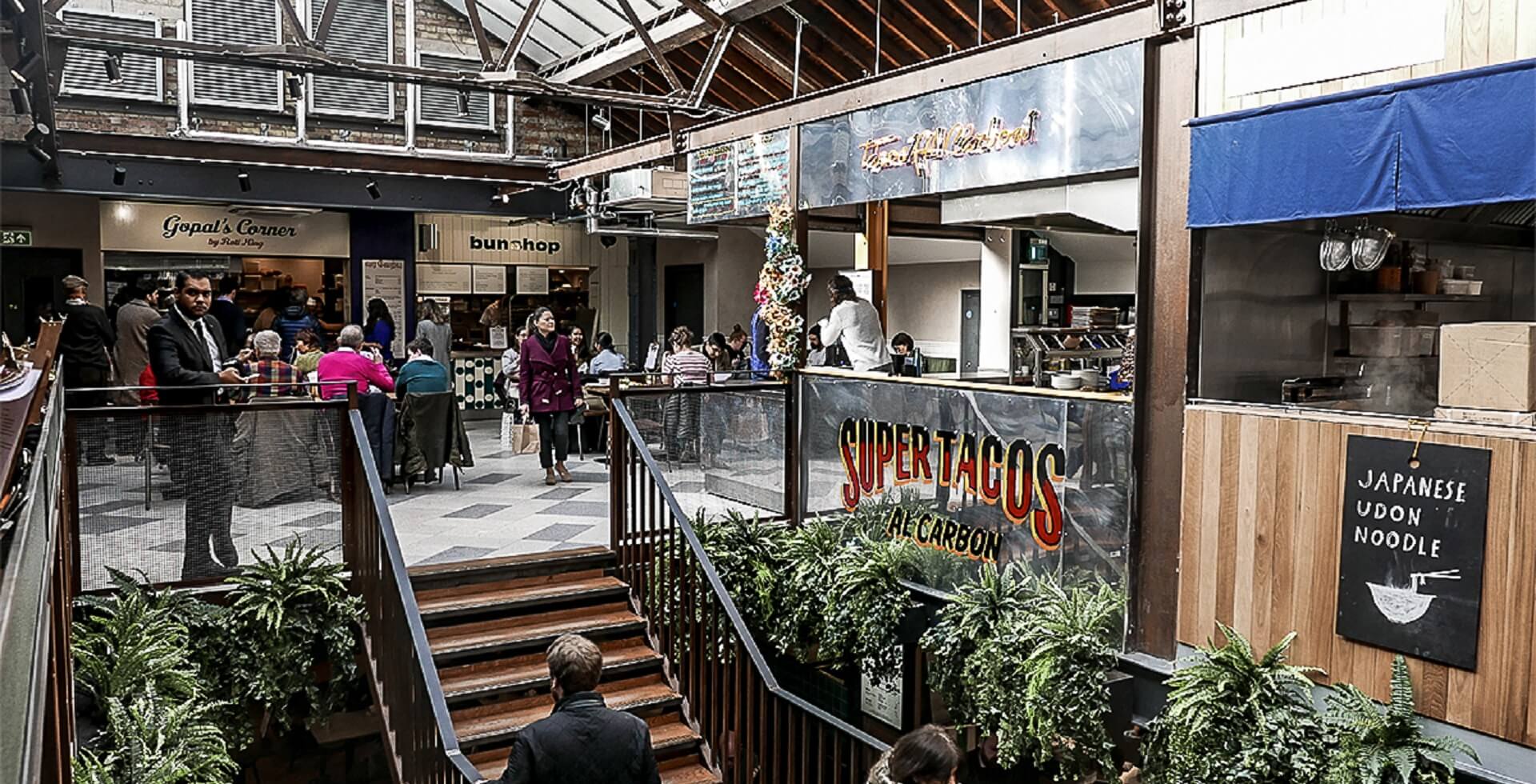Have you ever been in this situation? You open the menu – and you feel overwhelmed. Because every single dish is mouthwatering. You would prefer to order everything, but you know you have to decide. On a single dish.
And now let’s do the following thought experiment: Let’s multiply this overload by a factor of 10. Or 20. And that’s the indescribable enthusiastic overload that every hungry foodie feels when they enter a food court in 2023.
Sieh dir diesen Beitrag auf Instagram an
What are food courts?
Food courts are halls that house a wide range of restaurants and snack bars. To put it briefly: They offer everything a hungry heart could desire. Burgers, bowls, pizzas, falafel, not to mention the more unusual frills. Food courts are usually found in shopping centers. But they are also available at airports – and now even in specially designed halls. But more on that later.
One thing that all food courts have in common is the different gastronomy and snack concepts sharing one seating area. Tables and chairs, usually arranged in the middle, belong to the customers. Yes, the customers – not the guests. Because food courts usually have no service staff to bring the food to you. Instead, you pick up the food directly from the counter and sit down at one of the tables, which are located in a kind of communal area. A bit like in a canteen.
“But one thing that is required is people to clean up the dishes and cutlery, which is made of plastic and cardboard in some cases,” says Pierre Nierhaus. Born in Düsseldorf, he is one of the world’s most sought-after trend experts and concept consultants – and has traveled the vibrant metropolises around the world for around 20 years to carry out trend analyses.

Image: Pierre Nierhaus
Anyone listening to Nierhaus quickly notices that, gastronomically speaking, he knows every big city worth mentioning like the back of his hand. The gastronomy expert has been to New York alone over 85 times. He was particularly impressed by the food court phenomenon. In the last ten years, food courts in European countries as well as in other countries all over the world have experienced unrivaled success – at least in gastronomic terms. Why is this? And what will make a successful food court in the future?
Food courts: It all started with system gastronomy
“There are three generations of food courts”, Nierhaus explains. “The first was the traditional American shopping mall. There were several fast food concepts in a circle, with tables and plastic chairs in the middle. This has been so successful that many people still have exactly this picture in their minds when they think of food courts.”
According to Nierhaus, the second generation brought a groundbreaking leap in quality. This also started in the USA. But it spread rapidly in Asian countries such as Singapore, Japan and the Arab Gulf States. “This generation of food courts was found in upmarket shopping malls, so-called upscale malls. One thing that must not be underestimated: Malls like these have a completely different meaning in Asian countries or in the Gulf States. They stand for safety, but also for pleasant temperatures in a climate that is otherwise much too hot.”
Sieh dir diesen Beitrag auf Instagram an
In contrast to the first generation, food courts in these upscale malls did not just rely on the usual suspects from the world of system catering. Operators also used smaller concepts that created a more personal feel. “The seating also improved,” says Nierhaus. Instead of plastic tables and chairs with a camping character, upholstered seating was offered in places. “To this day, the best example of this is the Westfield shopping center in London with its really great food court”, says Nierhaus. “There are now concepts with open-plan kitchens, some of which even have restaurant-style seating. For me, the Westfield is proof that this second generation is still very in touch with modern times and successful.”
Global success
The success story of the time out markets began in Lisbon in 2014, in the historic Mercado da Ribeira market hall. The idea behind the concept: Bringing the best, most creative and representative F&B concepts in the city together under one roof. And not only to offer high-quality gastronomy options for locals, but also to introduce tourists to the widest possible range of regional cuisine in as little space as possible. 26 restaurant concepts and eight bars make the time out market in Lisbon a veritable paradise for foodies from near and far.
Sieh dir diesen Beitrag auf Instagram an
During the visit, you will notice: Time out isn’t all about traditional comfort. It’s loud here, it’s full here. Music drifts in from a side hall, where a concert is currently being held, even on a Tuesday at 10:35 a.m. The seating in the middle may be quite chic, but people still prefer to sit on one of the few seats at the side counter that surrounds the communal seating area. You get talking to other customers – or are they referred to as guests here? – almost automatically. You talk shop about food, wine, the city and its culinary delights, and, due to the noise, only understand half of what the other person is saying.
And yet all of this has a charm: Where else is such a wealth of high-quality, authentic cuisine from a country served in such a small space – and in such a great atmosphere? So it’s no wonder that the time out markets have expanded into the most vibrant cities in the world with great success in recent years. Dubai, New York, Miami, Chicago or Montreal.
Sieh dir diesen Beitrag auf Instagram an
Regional food courts, international management
“The recipe for success is definitely to rely on high-quality local heroes”, states Nierhaus, explaining the time out phenomenon. “And on those who all offer something different – and also to stay with what they offer. This not only ensures reliably high quality, but also a culinary diversity factor that is regional and representative of the respective location despite everything.”
But isn’t there a contradiction here? A food court concept with local heroes – but moving more towards an international chain with each location? Nierhaus doesn’t see it like this: “Running food courts requires a tremendous operational infrastructure. Whether it’s sinks, toilets, warehouses or kitchen equipment – these complex logistical issues require incredibly experienced professionals, otherwise it won’t work. This requires central management, central marketing, where all the know-how comes together. Many people now understand this – which is why we can expect that successful food court projects will continue to be created in the future.
So foodies can be sure: They will continue to experience overload when they enter a food court over the next few years Thank goodness.”















